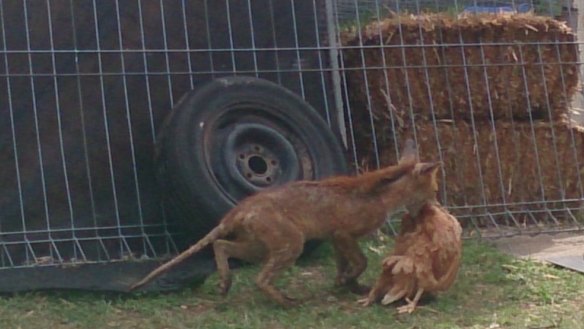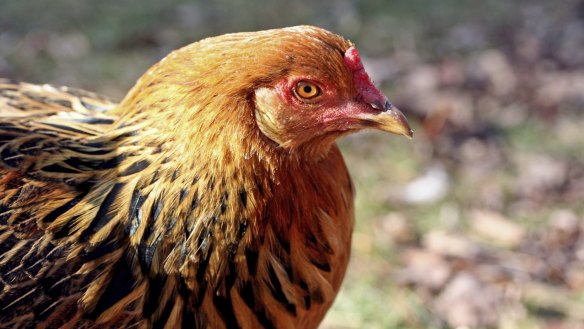How to set up backyard hens and fend off foxes in ACT region

There are few animals that will give you company and enjoyment and also provide you with daily supplies of quality food. A cow, of course, would fit this bill but that would be too much for the normal backyard. Hens are, on the other hand, much smaller and easier to manage and they can fit extremely well into any home with a decent backyard.
Our family has lived for 30 years on a small property just past the village of Hall and we have always had free-range hens keeping us company. They have contributed to cleaning up the overwintering codling moth in the ground around the apple trees in winter, and in preparing new garden areas, and provided us with rich, yellow, wholesome eggs.
As well, for the past 12 years, we have also had a Jersey cow named Princess, who was a gift to our daughter Felicity on her first assignment as an occupational therapist in Gippsland. Princess has produced three calves and continued to provide us with an excellent supply of cow manure for the compost.
But poultry, both hens and ducks, are fair game to marauding foxes that will attack them. For quite some years, I thought that foxes were a problem only for those living in the rural fringe but I have heard too many sad stories of attacks in the suburbs to think it is just a rural problem.

We have had our share of tragedies as our four children were growing up. Foxes will try to find gaps in fences, climb over fences or dig under fences. Foxes are wasteful and destructive, grabbing as many chickens as they can by the neck and killing them all, taking them away one at a time to feed their young pups.
So, we have invested in a flexible electric fencing system and when it is working properly, it will deter foxes, as they will be zapped by several wires as they try to push through. The 50-metre lengths of netting are manufactured in England and supplied by Gundaroo Tiller, Tools and Equipment. The fencing requires a pulsator unit, which can be run off a battery or off mains electricity.
Like most backyard hen-owners, we have built solid wooden hen houses for our hens which can be moved around the orchard areas. However, there have been occasions when the battery was left too long and it ran down, or a low wire in the fence broke from old age, or once, a strong wind blew over the entire fence. The wily fox will be preying around and will somehow manage to get through. It will then dig underneath the secure hutch. You will probably wake again to the sounds of slaughter.
So, in recent years we have added a third defence barrier and it has been very successful. Steel mesh that is 300-400mm wide is now laid out around all sides of the hen house as a protective barrier.
The fox can no longer dig. In the backyard, you can lay mesh below the entire chicken house and simply move it when you move your coop to new ground. For those with a permanent structure, dig mesh into the ground where you have constructed your perimeter fence, down to a depth of 150mm.
When you have just a small number of hens, they will probably be named, and they become close friends. They cluck around your feet and they become little chicken tractors, scratching the soil for grubs and insects. They can catch an amazing number of grasshoppers if any are blown in on the summer winds.
Hens also produce a regular supply of manure. When the enclosure is placed onto a garden bed, they can provide a natural means of renewing the soil, digging out weeds and supplementing the fertility of the soil with their manure. We recently set up our hens to dig and scratch the area where we wanted to plant out a new strawberry garden. They did a fine job and now the rows of strawberries are emerging from their winter hibernation.
Hens also love to have a perch and need a dark place for laying their eggs. Provide a nesting box and keep some fresh straw in it for the eggs to have a soft landing. So, even if you want to keep just a few hens at home, there is plenty to consider and lots to do, but you will find it is really worth it.

There are many pure bred breeds of hens and each breed has many devoted followers who will breed and exhibit at shows around the country. Rhode Island Reds and Whites are our favourite breed because they are good layers and can manage well in both the cold winters and the hot summers. They are hardy as well as friendly.
So, too, are the other good brown egg-layers, the large, gentle Plymouth Rock hens. Both breeds will lay around 250 eggs a year and can live for five to six years. The Leghorn is a white bird that is an excellent egg-producer, laying up to 300 white-shelled eggs a year.
There are also many bantam-sized breeds. We keep Rhode Island Red and Langshan hens because they are hardy and can withstand the cold winds blowing across the ranges in late winter. They do not dig as deeply around the roots of the fruit trees as do the large hens. However, if you have a good protected site, there are many lovely alternatives, including wyandottes, silkies, pekins, frizzles and araucanas.
Hybrid breeds, including Isa Brown and Hy-line, have become popular for those who just want a regular supply of eggs. Farm supply companies Powells Stockfeeds in Phillip and Gibbs Farm Centre in Queanbeyan stock the hybrid Isa Brown hens, at point of lay. They are excellent layer birds and are generally quiet and friendly for children. They do, however, have a short life when their laying days finish after just two summers.
We have sourced organic wheat supplies for many years, but the protein ratio in wheat is just 14 per cent and for good egg production you need a ratio of 16 per cent or higher. Free-range chickens will supplement their protein intake by eating grubs and insects. A small meat meal supplement is one answer, or a pre-mixed pellet or mash feed will provide your full requirements.

Country Heritage Feeds in Queensland is the main supplier of organic free-range stockfeeds. The organic layer mash is a certified organic complete feed. It offers a minimum 18 per cent protein ratio, along with essential vitamins and minerals. Powells Stockfeeds in Phillip and Brindabella Stockfeeds in Hume stock the 20-kilogram bags of free-range layer mash and mixed grain. Remember to also buy a supply of medium shell grit for the hens to eat, as the calcium is necessary for producing strong egg shells.
Baked zucchini and capsicums with eggs
3 gloves garlic, crushed
2 tsp grapeseed oil
1 brown onion
2 medium zucchinis
3 green and red capsicums
4 Roma tomatoes
½ tsp ground cumin
½ tsp ground coriander
¼ tsp ground nutmeg
½ cup vegetable stock
6 free range eggs
½ cup milk
salt and black pepper
Finely chop the onions and saute the garlic and onion until the onion is translucent. Slice the zucchinis and capsicums and dice the tomatoes. Add the vegetables and spices to the onions and cook on a low heat for a further three minutes, stirring regularly. Pour in the vegetable stock and cook over low heat for 15 minutes until most of the liquid has evaporated.
Lightly beat the eggs with the milk, with a whisk in a small bowl. Add a sprinkling of salt and pepper. Transfer vegetables into a lightly greased baking dish and pour in the egg mixture. Place in an oven set at 180C. Cover with a lid and bake for 30 minutes. Remove the lid and continue for another 10 minutes to brown the top.
This week in the garden
* With all the rain in the past few weeks, identify any sections of the garden that need additional drainage. Dig out perimeter trenches and fill with rubble to allow surplus water to drain away. Look at building up beds higher than the surrounding ground level.
* Plant out a mixed crop of carrot and radish. Spread the seeds very thinly along the rows and cover with a very thin layer of soil. The radishes will emerge quickly and break up the soil surface for the carrots. They can be harvested in four to five weeks, leaving more space for the carrots to grow.
* Plant out beetroot and silverbeet seeds directly into the garden bed.
* Dig over a garden bed for planting potatoes later in the month. Make sure to avoid a bed that has grown any of the solanum family in the past two years (tomatoes, capsicums or similar).
* Weeding will take lots of time and energy this month. Aim to provide a good layer of mulch around your plants after weeding, to suppress further competitive weeds and provide cover for when the days become much warmer.
Owen Pidgeon runs the Loriendale Organic Orchard near Hall.
Restaurant reviews, news and the hottest openings served to your inbox.
Sign up